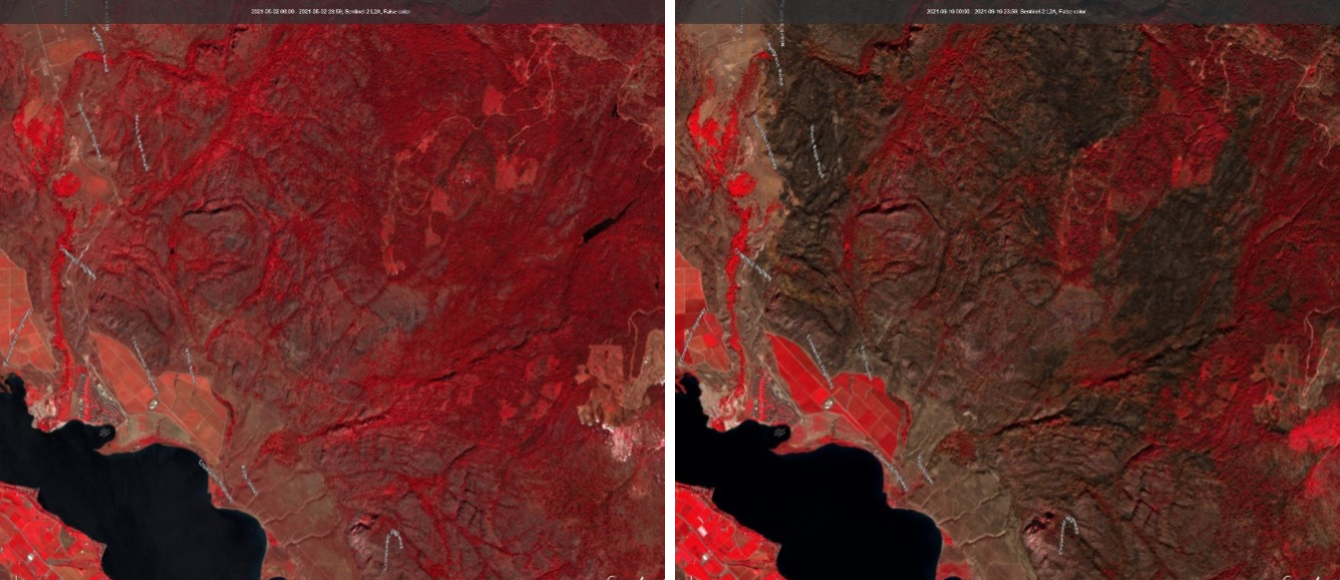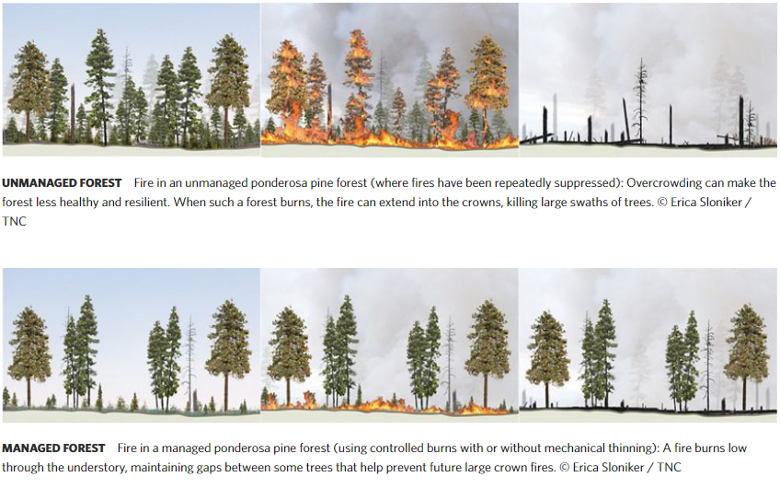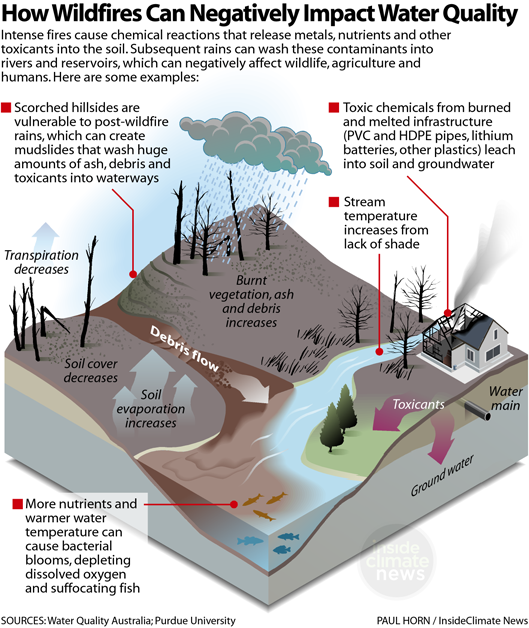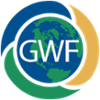Ash down the pipes? Wildfires and potable water security in Canada
Part 1: Broken forests
By François RobinneAfter a relentless 2021 fire season, it seems that ashes are slowly settling down on the scorched forests of Canada. Knock on burnt wood. Soon will come the time to rest minds and bodies, rebuild communities and trust, act on climate change…and, unfortunately, worry again. The flames might be out, but changes to the land will remain for a while—decades, most likely—and this is not good news for our water supply [1].
As a research scientist at the Great Lakes Forestry Centre from the Canadian Forest Service (formerly a GWF postdoctoral fellow), my work focuses on wildfire risks to water security. This emerging topic is gaining traction, but it remains generally unknown to Canadians. I hope these wildfires and water articles can contribute to risk awareness in an era of rapid water and forest changes.

Forests are a crucial component of the water cycle [2,3]: they transpire and help regulate local climates; they absorb and store water, acting like a sponge, and thus regulate water availability; and they filter water, thereby naturally enhancing water quality. These processes and functions provide essential ecosystem services that benefit our society, from drinking water to fishing to flood control to electricity. In sum, forests protect our water resources, leading one to think well the more forest, the better. After all, it's sold as the silver bullet for climate change, so why not for water too?
But it turns out too much forest is not a good thing. I know this is anathema, but I stand by it.
Let me explain.
In forested watersheds of Canada where nature has been allowed to follow its course, forests, waters, and wildfires work in a nexus [4–6]: forests contribute to the water cycle and regulate downstream water resources; waters redistribute sediments and nutrients, as well as harbor a wealth of aquatic dwellers, and occasionally, sustain human activities; finally, wildfires keep the forest healthy through rejuvenation and diversification, which in turn keeps water flowing.

Here: we went full circle!
Early in the 20th century, Canadian federal and provincial governments decided to push fire out of the equation in a large-scale attempt to protect timber resources and forest communities [5]. Naturally-occurring wildfires and traditional fire use by First Nations were judged undesirable and excluded. But here is the catch—or failure of foresight: without fire, the nexus brakes down. No blaze means that vegetation can keep growing unchecked. Unbounded forest growth means more competition for water, with negative consequences to forest health and water resources [7]. Excessive biomass, tree mortality, and generalized water stress end up turning watersheds into matchboxes. Then comes the spark…
Fire exclusion created a fire debt, which we are now reimbursing with exorbitant interests. This year, the record-breaking fire season in Canada, crystallized by the destruction of several communities in British Columbia, is very much the product of the now obsolete fire management strategy [5].
Or, at least, for a good part. Climate change, the so-called threat multiplier, is indeed making the fire exclusion problem much worse. Heat is the primary factor driving the water cycle, and with excessive heat trapped due to excessive GHG emissions, weather and climate extremes are becoming more frequent and acute [8]. The resulting heatwaves and droughts that we have experienced this year all across the country directly affect fire danger by making forest fuels much more responsive to the flames: they burn more readily, faster, and hotter [9,10].
One might now ask: okay, what does your rant on fire do with potable water security?
Hold on, butterfly, I’m getting there.
The compounded effects of fire exclusion and climate change on forests are dangerously increasing fire frequency, size, and severity in proportions detrimental to forest ecosystems. After the blaze, unusual fire impacts combined with warmer, drier conditions will also make forest regrowth more challenging, slowly turning watersheds into barren lands [11,12]. In the end, the ability of forested watersheds to provide water, both in the short-term and long-term, will no longer be granted.
Wildfire risks to water security—potable water in particular—have been increasingly studied in Canada and elsewhere for the last decade or so [13]. Although each at-risk situation is different—given the diversity of forests, fire regimes, water demand, etc.—there are general cascading and detrimental effects to be aware of [1,14].

From a public health perspective, risks to drinking water from wildfires are considered relatively low but very real [15]. Although several chemical compounds—either directly from burned areas or from the disinfection process—have been identified as potentially dangerous, they are highly monitored within the Canadian drinking water industry, and water distributed at the tap remains safe. If raw water is deemed untreatable, a drinking water treatment plant would shut the intake and switch to a backup source or rely on existing storage. That said, the multiplication of pressures on water resources from climate change and ever-increasing water demand might make it easier for incidents to happen [16,17].
The main risk of wildfires relates to the overall costs of producing clean drinking water [18,19]. Damages to (infra)structures, treatment systems wearing out faster, increased monitoring needs, system adaptation to extreme events, and potential forest restoration work in the watershed. All these combine to make the costs of drinking water production and distribution higher. Eventually, these costs will cascade until they reach our water bills. In what proportions? It's an open question, but something is telling me that none of us will like the answer.
After what happened during this fire season in Canada, the aftermath of our drinking water production capacities needs to be seriously investigated. There is an increasing demand to be proactive. To look at the problem from an integrated risk management perspective [1]. After all, a water treatment plant is but a small piece of the water security puzzle. What if a watershed can't provide safe drinking water anymore? What if the community doesn't have a backup water source? What if…? A 'what-if' scenario approach is commonly used in risk assessment to investigate things that could plausibly go wrong and what their effects might be. Given this fire season and accelerating climate change, no scenario should be off the table. But at the core of risk analysis lies data, which we surprisingly lack on this very topic at the moment in Canada. Don't worry; we'll be tackling this very topic in Part 2 of this water and wildfires series.
References
If you want to read more on this subject feel free to check out all the resources used to write this article below.
- Robinne, F.-N.; Hallema, D.W.; Bladon, K.D.; Flannigan, M.D.; Boisramé, G.; Bréthaut, C.M.; Doerr, S.H.; Di Baldassarre, G.; Gallagher, L.; Hohner, A.K.; et al. Scientists’ warning on extreme wildfire risks to water supply. Hydrol. Process. 2021, hyp.14086, doi:10.1002/hyp.14086.
- Creed, I.F.; Jones, J.A.; Archer, E.; Claassen, M.; Ellison, D.; McNulty, S.G.; van Noordwijk, M.; Vira, B.; Wei, X.; Bishop, K.; et al. Managing Forests for Both Downstream and Downwind Water. Front. For. Glob. Chang. 2019, 2, 1–8, doi:10.3389/ffgc.2019.00064.
- Ellison, D.; Morris, C.E.; Locatelli, B.; Sheil, D.; Cohen, J.; Murdiyarso, D.; Gutierrez, V.; Noordwijk, M. van; Creed, I.F.; Pokorny, J.; et al. Trees, forests and water: Cool insights for a hot world. Glob. Environ. Chang. 2017, 43, 51–61, doi:10.1016/j.gloenvcha.2017.01.002.
- Ireson, A.M.; Barr, A.G.; Johnstone, J.F.; Mamet, S.D.; van der Kamp, G.; Whitfield, C.J.; Michel, N.L.; North, R.L.; Westbrook, C.J.; DeBeer, C.; et al. The changing water cycle: the Boreal Plains ecozone of Western Canada. WIREs Water 2015, 2, 505–521, doi:10.1002/wat2.1098.
- Brandt, J.P.; Flannigan, M.D.; Maynard, D.G.; Thompson, I.D.; Volney, W.J.A. An introduction to Canada’s boreal zone: ecosystem processes, health, sustainability, and environmental issues. Environ. Rev. 2013, 21, 207–226, doi:10.1139/er-2013-0040.
- Pausas, J.G.; Keeley, J.E. Wildfires as an ecosystem service. Front. Ecol. Environ. 2019, 17, 289–295, doi:10.1002/fee.2044.
- Stephens, S.L.; Thompson, S.; Boisramé, G.; Collins, B.M.; Ponisio, L.C.; Rakhmatulina, E.; Steel, Z.L.; Stevens, J.T.; van Wagtendonk, J.W.; Wilkin, K. Fire, water, and biodiversity in the Sierra Nevada: a possible triple win. Environ. Res. Commun. 2021, 3, 081004, doi:10.1088/2515-7620/ac17e2.
- Canada’s Changing Climate Report; Bush, E., Lemmen, D.S., Eds.; Government of Canada: Ottawa, ON, 2019; ISBN 8199383860.
- Wang, X.; Thompson, D.K.; Marshall, G.A.; Tymstra, C.; Carr, R.; Flannigan, M.D. Increasing frequency of extreme fire weather in Canada with climate change. Clim. Change 2015, 130, 573–586, doi:10.1007/s10584-015-1375-5.
- Kirchmeier-Young, M.C.; Zwiers, F.W.; Gillett, N.P.; Cannon, A.J. Attributing extreme fire risk in Western Canada to human emissions. Clim. Change 2017, 144, 365–379, doi:10.1007/s10584-017-2030-0.
- Coop, J.D.; Parks, S.A.; Stevens-Rumann, C.S.; Crausbay, S.D.; Higuera, P.E.; Hurteau, M.D.; Tepley, A.; Whitman, E.; Assal, T.; Collins, B.M.; et al. Wildfire-Driven Forest Conversion in Western North American Landscapes. Bioscience 2020, 70, 659–673, doi:10.1093/biosci/biaa061.
- Whitman, E.; Parisien, M.-A.; Thompson, D.K.; Flannigan, M.D. Short-interval wildfire and drought overwhelm boreal forest resilience. Sci. Rep. 2019, 9, 18796, doi:10.1038/s41598-019-55036-7.
- Robinne, F.-N.; Hallema, D.W.; Bladon, K.D.; Buttle, J.M. Wildfire impacts on hydrologic ecosystem services in North American high-latitude forests: A scoping review. J. Hydrol. 2020, 581, 124360, doi:10.1016/j.jhydrol.2019.124360.
- Kemter, M.; Fischer, M.; Luna, L. V.; Schönfeldt, E.; Vogel, J.; Banerjee, A.; Korup, O.; Thonicke, K. Cascading Hazards in the Aftermath of Australia’s 2019/2020 Black Summer Wildfires. Earth’s Futur. 2021, 9, e2020EF001884, doi:10.1029/2020EF001884.
- Hohner, A.K.; Rhoades, C.C.; Wilkerson, P.; Rosario-Ortiz, F.L. Wildfires alter forest watersheds and threaten drinking water quality. Acc. Chem. Res. 2019, 52, 1234–1244, doi:10.1021/acs.accounts.8b00670.
- Delpla, I.; Jung, A.-V.; Baures, E.; Clement, M.; Thomas, O. Impacts of climate change on surface water quality in relation to drinking water production. Environ. Int. 2009, 35, 1225–1233, doi:10.1016/j.envint.2009.07.001.
- Leveque, B.; Burnet, J.-B.; Dorner, S.; Bichai, F. Impact of climate change on the vulnerability of drinking water intakes in a northern region. Sustain. Cities Soc. 2021, 66, 102656, doi:10.1016/j.scs.2020.102656.
- Khan, S.J.; Deere, D.; Leusch, F.D.L.; Humpage, A.; Jenkins, M.; Cunliffe, D. Extreme weather events: Should drinking water quality management systems adapt to changing risk profiles? Water Res. 2015, 85, 124–136, doi:10.1016/j.watres.2015.08.018.
- Ho Sham, C.; Tuccillo, M.E.; Rooke, J. Effects of Wildfire on Drinking Water Utilities and Best Practices for Wildfire Risk Reduction and Mitigation; Denver, 2013;
